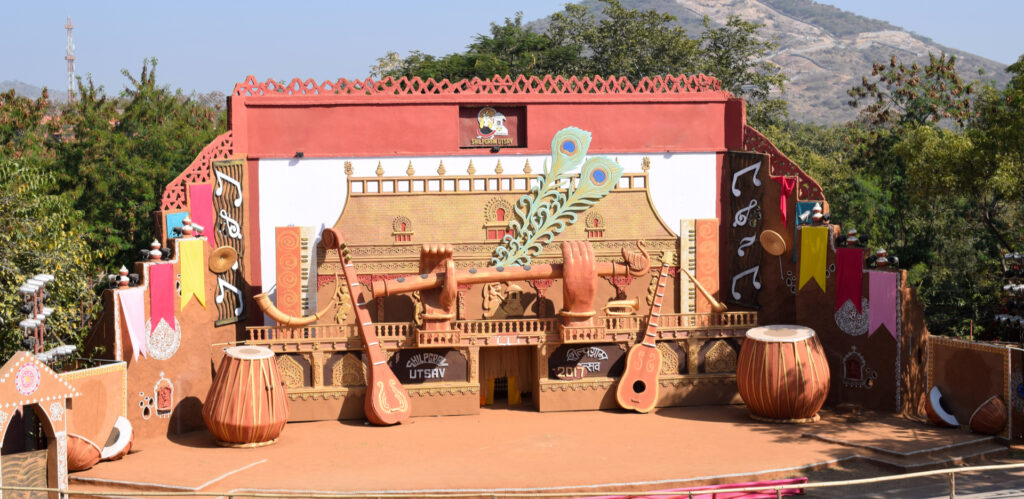As the winter sun dips behind the Aravalli Hills, casting a golden hue across the landscape of Udaipur, a vibrant melody begins to rise from the western outskirts of the city. It is December, and the dusty paths of Shilpgram, the rural arts and crafts village, are awakening with color, rhythm, and the scent of earthy traditions. This is no ordinary gathering — it is the beginning of the Shilpgram Fair, one of India’s most cherished cultural festivals.
🌾 A Journey Into the Heart of Rural India
“Shilpgram” translates to “crafts village,” and true to its name, this open-air ethnographic museum — spread over 70 acres — is a tribute to India’s rural artisans, especially those from Rajasthan, Gujarat, Maharashtra, and Goa. But during the annual Shilpgram Utsav, held every year in the last week of December, the village transforms into a lively cultural carnival.
I remember my first visit vividly. The moment I stepped through the rustic gates of Shilpgram, it felt like stepping into a time machine — one that whisked me away from the chaos of city life to a world where culture, tradition, and artistry breathed freely.
🛍️ A Marketplace of Masterpieces
As I wandered along the winding pathways, I was drawn into stalls bursting with handmade treasures. Each booth was a living story, manned by artisans who had traveled from distant villages with bags full of dreams and handcrafted marvels. There were mirror-embroidered fabrics from Gujarat, blue pottery from Jaipur, brass wares from Maharashtra, coir crafts from Goa, and so much more.
What amazed me wasn’t just the variety, but the passion in the hands that made them — an old woman weaving colorful wool rugs on a wooden loom, a potter shaping clay with mesmerizing skill, a young artist painting intricate miniature artworks without ever lifting his wrist.
These weren’t just products; they were legacies.
🎶 The Rhythm of Traditions
As dusk approached, the energy in the air shifted. The central amphitheater — known as the Kalangan — came alive with beating drums, clapping hands, and the whirl of ghagras (long skirts). The Shilpgram Fair is as much about performances as it is about crafts. Folk dancers from across India took center stage. I watched, spellbound, as the Kalbeliya dancers from Rajasthan spun like wind, their black dresses trailing like smoke, while Lavani performers from Maharashtra enchanted the crowd with their grace and expressions.
Musicians played traditional instruments I had never seen before — the morchang, algoza, and dhol. Their music was primal, pure, and pulled something deep from within the soul.
The most unforgettable was a puppet show by a Rajasthani family, where the father narrated folk tales, the mother played the dholak, and the children managed the puppets — all in perfect synchrony.
🍛 A Feast for the Senses
What is a fair without food? Between the crafts and the concerts, my senses were lured by the aroma of fresh kachoris, spicy dal baati churma, and sweet malpuas. Each regional stall served its specialties — whether it was Goa’s coconut laddus or Gujarat’s dhokla, everything was rich in flavor and authenticity.
Sitting cross-legged under a thatched roof, I shared a meal with strangers who felt like friends. Conversations flowed over chai in kulhads (clay cups), and laughter echoed through the open air.
✨ More Than Just a Fair
What makes the Shilpgram Fair so special isn’t just its scale or diversity — it’s the feeling it evokes. It is a reminder that behind the glitter of modern cities lies an India that is raw, rooted, and deeply beautiful. Here, creativity isn’t taught in schools, but passed down through generations, carved into every piece of wood, sewn into every fabric, and danced into every movement.
For artisans, this fair isn’t just an exhibition — it’s their livelihood, their pride, and their moment to shine.
For travelers, it’s a chance to experience the soul of India, far away from packaged tours and hotel lobbies.
And for me? It was a story — one of color, connection, and culture that I carry in my heart even today.
📌 Know Before You Go
- When: Last week of December (Usually from December 21 to 31)
- Where: Shilpgram, 3 km west of Udaipur city
- Entry Fee: Nominal
- Tips:
- Visit in the afternoon to explore crafts, and stay for evening performances.
- Wear comfortable shoes and carry cash for shopping.
- Don’t miss the regional food stalls!
